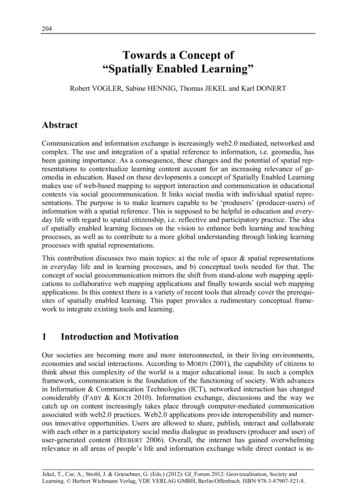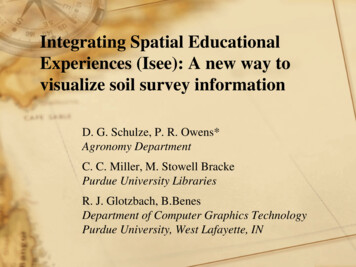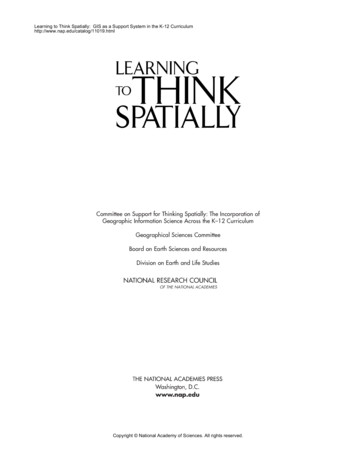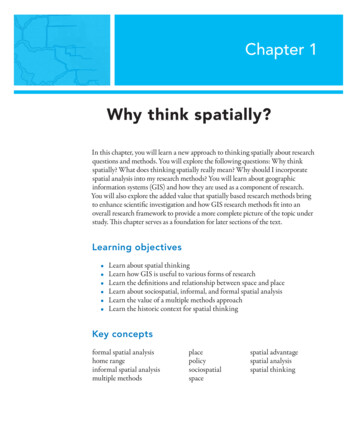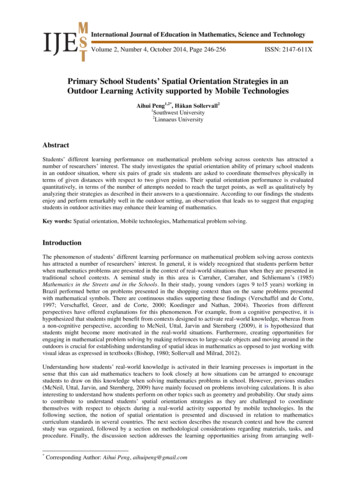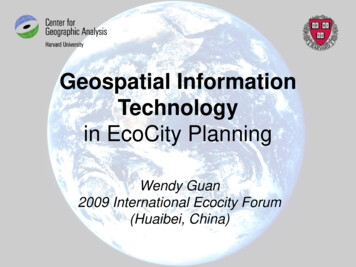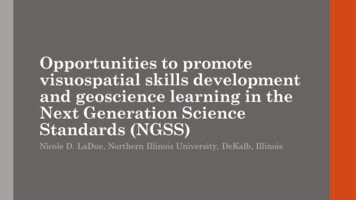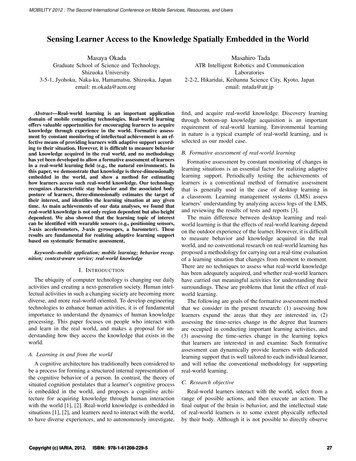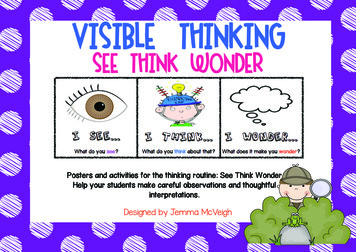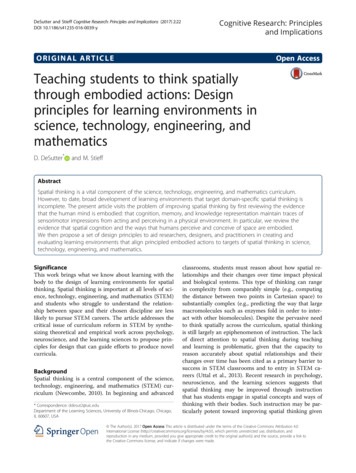
Transcription
DeSutter and Stieff Cognitive Research: Principles and Implications (2017) 2:22DOI 10.1186/s41235-016-0039-yCognitive Research: Principlesand ImplicationsORIGINAL ARTICLEOpen AccessTeaching students to think spatiallythrough embodied actions: Designprinciples for learning environments inscience, technology, engineering, andmathematicsD. DeSutter*and M. StieffAbstractSpatial thinking is a vital component of the science, technology, engineering, and mathematics curriculum.However, to date, broad development of learning environments that target domain-specific spatial thinking isincomplete. The present article visits the problem of improving spatial thinking by first reviewing the evidencethat the human mind is embodied: that cognition, memory, and knowledge representation maintain traces ofsensorimotor impressions from acting and perceiving in a physical environment. In particular, we review theevidence that spatial cognition and the ways that humans perceive and conceive of space are embodied.We then propose a set of design principles to aid researchers, designers, and practitioners in creating andevaluating learning environments that align principled embodied actions to targets of spatial thinking in science,technology, engineering, and mathematics.SignificanceThis work brings what we know about learning with thebody to the design of learning environments for spatialthinking. Spatial thinking is important at all levels of science, technology, engineering, and mathematics (STEM)and students who struggle to understand the relationship between space and their chosen discipline are lesslikely to pursue STEM careers. The article addresses thecritical issue of curriculum reform in STEM by synthesizing theoretical and empirical work across psychology,neuroscience, and the learning sciences to propose principles for design that can guide efforts to produce novelcurricula.BackgroundSpatial thinking is a central component of the science,technology, engineering, and mathematics (STEM) curriculum (Newcombe, 2010). In beginning and advanced* Correspondence: ddesut2@uic.eduDepartment of the Learning Sciences, University of Illinois-Chicago, Chicago,IL 60607, USAclassrooms, students must reason about how spatial relationships and their changes over time impact physicaland biological systems. This type of thinking can rangein complexity from comparably simple (e.g., computingthe distance between two points in Cartesian space) tosubstantially complex (e.g., predicting the way that largemacromolecules such as enzymes fold in order to interact with other biomolecules). Despite the pervasive needto think spatially across the curriculum, spatial thinkingis still largely an epiphenomenon of instruction. The lackof direct attention to spatial thinking during teachingand learning is problematic, given that the capacity toreason accurately about spatial relationships and theirchanges over time has been cited as a primary barrier tosuccess in STEM classrooms and to entry in STEM careers (Uttal et al., 2013). Recent research in psychology,neuroscience, and the learning sciences suggests thatspatial thinking may be improved through instructionthat has students engage in spatial concepts and ways ofthinking with their bodies. Such instruction may be particularly potent toward improving spatial thinking given The Author(s). 2017 Open Access This article is distributed under the terms of the Creative Commons Attribution 4.0International License (http://creativecommons.org/licenses/by/4.0/), which permits unrestricted use, distribution, andreproduction in any medium, provided you give appropriate credit to the original author(s) and the source, provide a link tothe Creative Commons license, and indicate if changes were made.
DeSutter and Stieff Cognitive Research: Principles and Implications (2017) 2:22an increasing corpus of evidence that human knowledgeabout space is embodied.Preparing the next generation of STEM professionalsrequires critically examining and re-envisioning teachingand learning settings so that spatial thinking is elevatedto a targeted objective of learning and is engendered asan essential habit of mind (National Research Council,2006). First and foremost, spatial thinking is exercisedextensively by experts: scientists across the STEMspectrum regularly reason about the relationship between the concrete and theoretical entities they study,their complex spatio-dynamic properties, and how theseproperties give rise to macroscopic observations. Theability to think spatially has led to some highly visibleand significant scientific breakthroughs (National Research Council, 2006; Uttal & Cohen, 2012): Watsonand Crick’s construction of the DNA double helix,Rutherford’s deduction of the presence of the nucleus,and Pasteur’s account of light polarizing tartaric salts; allrepresent discoveries that required extensive thoughtabout the relationship between space and the physicalproperties of nature. Moreover, retaining and producingmore successful graduates in STEM disciplines represents an economic and strategic imperative sharedacross OECD member countries (OECD, 2012). In theUSA, the Obama administration recently set a goal ofproducing 1,000,000 new STEM graduates within thenext decade. Troublingly, of the students enrolling inSTEM degree programs, currently only 40% are following these degrees to completion. Students leave theSTEM pipeline for myriad reasons, but challenges related to spatial thinking have been identified as animportant factor that contributes to their pursuit ofalternative careers (National Research Council, 2006;Uttal et al., 2013).The call for reform is clear and many learning environments have emerged in which students are trained inthe critical aspects of spatial thinking. These learningenvironments, which are physical and cultural contextsengineered with the express purpose of facilitating theattainment of target learning objectives by a specificaudience, vary vastly in their design principles. Wheresome attempt to improve STEM outcomes by trainingstudents in domain-general skills (Miller & Halpern,2013; Sorby, 2009), others leverage domain-specifictools, such as molecular models, to help students reasonabout complex spatiotemporal dynamics (Stull, Hegarty,Dixon, & Stieff, 2012). However, despite such efforts togive students training in spatial thinking to improve outcomes in the STEM classroom, these learning environments make different assumptions about the nature ofspatial thinking and, as such, propose substantially different solutions to support students as they learn to reason about space. Given the variation in assumptions inPage 2 of 20the literature, a fundamental question needs to be addressed: what exactly do we mean by spatial thinking?On defining spatial thinking and its importance in thecurriculumResearchers have historically focused on the relativelynarrow cognitive construct of spatial ability to quantifyhuman propensity to reason about space. Studies ofspatial ability grew out of a long history of psychometricdevelopment in early psychology and this line of workassumed that humans have some genetically determinedbaseline capacity to perceive, mentally visualize, and manipulate spatial relationships. Research in this traditionhas argued that individual and group differences inspatial ability are a prominent causal factor that can account for attrition in the STEM pipeline. This positionargues that students with low spatial ability are less ableto visualize and operate on the spatial relationships thatunderlie disciplinary concepts in STEM and that thisnegatively impacts these students very early in theircourse of study (Uttal & Cohen, 2012; Wai, Lubinski, &Benbow, 2009). A number of correlational studies haveattempted to establish the link between spatial abilityand spatial thinking in STEM by demonstrating correlations between spatial ability and course-based achievement measures in physics (Kozhevnikov, Motes, &Hegarty, 2007), chemistry (Bodner & McMillan, 1986;Pribyl & Bodner, 1987), and geology (Kali & Orion,1996) among many others (for a review cf. Hegarty,2014). These findings have been further bolstered bylongitudinal analyses that show persistent relationshipsbetween measures of spatial ability (e.g., mental rotation,paper folding, and perspective taking) and the likelihoodan individual will perform well in STEM courses andpursue a career path in STEM (Wai et al., 2009).The logic goes that if individual differences in spatialability are in fact an important causal factor that cascades through a student’s immediate success and latercareer choice, students of lower spatial ability are selectively disadvantaged by current curricula and should besupported through training targeted at improving individual spatial ability. Recent meta-analytic work has provided further impetus for a focus on training spatialability, concluding that spatial ability is in fact responsiveto instruction (Uttal et al., 2013). Some notable studieshave even empirically demonstrated that training students in domain-general spatial tasks positively correlates with higher achievement scores on domain-specificoutcome measures (Small & Morton, 1983; Sorby, 2009).However, despite the empirical rationale to design learning environments that teach domain-general spatial ability as a means to improve STEM achievement, critiquesagainst this line of work argue that correlations betweenspatial ability and achievement remain weak to moderate
DeSutter and Stieff Cognitive Research: Principles and Implications (2017) 2:22(r 0.2 to 0.3; Hegarty, 2014). Moreover, extant workhas not clearly established that the relationship betweentraining spatial ability and STEM achievement is causal(Stieff & Uttal, 2015). Even in studies where spatial ability is improved through sustained practice, the benefitsof the training do not transfer unilaterally across allSTEM disciplines and these benefits decline rapidly aftertraining (e.g., Miller & Halpern, 2013).While traditional conceptions of spatial ability areclearly related to STEM career choice and courseachievement, measures of spatial ability may simplynot capture the more complex forms of spatial thinking that characterize STEM curricula and the disciplines more broadly (National Research Council,2006). In fact, although spatial ability is an independent predictor of performance and attainment inSTEM, this relationship does not hold for experts andmay not characterize the rich knowledge base that experts draw on (Uttal & Cohen, 2012). Hegarty (2014)argued that the lack of clear causal evidence linkingincreases on measures of spatial ability resulting fromtraining to improved performance in STEM disciplines opens the question of how spatial skills shouldbe taught: should the focus be on domain-generalskills such as mental rotation or do training studiesneed to be designed around “ the context of specific [disciplinary] content (e.g., facility in rotatingmolecules in chemistry)” (p. 151).A broader interpretation of the cognitive componentsthat learners require to succeed as spatial thinkers maybe generative toward identifying the shared and domainspecific challenges in the STEM curriculum. Such workmay also better identify instructional targets that canmitigate the challenges learners have thinking spatiallythat are not captured in domain-independent trainingregimes. Spatial thinking is a more generalized constructthat “ is broader than spatial ability and related concepts in that it approaches the process of problem solving via the coordinated use of space, representation, andreasoning” (National Research Council, 2006, p. 27).Spatial thinking in this sense acknowledges that concepts of space are often drawn on by multiple disciplines, but that the application of spatial concepts isentwined with discipline-specific practices. For example,although engineers and mathematicians both reasonabout the extent of objects in space, engineers mightdo so in the context of a computer-assisted design(CAD) application where they design precisely balanced machine parts that they dynamically view frommultiple angles. A mathematician, on the other hand,may use a numerical computation engine such asMATLAB to investigate optimization procedures forhypersphere packing in non-Euclidean N-dimensionalhyperbolic space.Page 3 of 20While these examples both draw on the same conceptof space (“extent of an object”), the notion of spatialthinking provided by the National Research Council(2006) highlights that the contexts of use and forms ofrepresentation used by an engineer and a mathematicianas well as the rationale propelling their lines of work differ in important ways. Because the spatial thinking construct brings a focus to the use of space during problemsolving, it readily subsumes many traditional conceptions of visuospatial ability, but it also meaningfully extends the analysis of problem solving to consider therepresentational contexts of use (e.g., diagrams, maps,computer visualizations) as well as the processes of reasoning (e.g., drawing on concepts of space to structure aproblem solution and construct inferences about a possible solution strategy). The power of the spatial thinkingconstruct rests precisely in its ability to focus attentionon shared aspects of spatial thought across STEM whilealso highlighting that these shared practices instantiatedifferently depending on the disciplinary context. Thereis no short list of concepts that are expressed in alanguage of space: biologists use space to explain thestructure–function relationships in biological systems,chemists use space to explain how molecules are structured and interact during a reaction, civil engineers usespace to design skyscrapers and test the impacts of windshear. Each discipline reasons about space, but employsdifferent ways of expressing space via representationsand tools, and employs specific ways of framing disciplinary problems and scientific inquiry.Reframing spatial thinking in this way will not only begenerative toward conceiving new learning environmentsthat exist outside the historically narrow notions of howto improve STEM achievement, it also has the potentialto address misconceptions around who can succeed inscience. This characterization of spatial thinking doesnot mandate a singular approach to curriculum reform:rather, it suggests that diverse learning environmentscan address spatial thinking in a discipline in substantially different ways. This flexibility provides amplecreative space for researchers and practitioners toconsider ways to increase students’ “STEM dose”early on and potentially increase the likelihood thatthey pursue STEM careers in their professional lives(cf. Wai, Lubinski, Benbow, & Steiger, 2010). Morecrucially, conceiving of spatial thinking as a flexibleframework with no singular application affords significant intellectual diversity: research questions canmove away from framing learning in deficit, as in thecase of training spatial ability. This is particularlyconsequential when considering that the targets ofthese deficit models often and disproportionately arewomen and historically underrepresented minorities(Newcombe & Stieff, 2012).
DeSutter and Stieff Cognitive Research: Principles and Implications (2017) 2:22In our research, we study how spatial thinking can beimproved by designing learning environments that havestudents use their bodies to represent and enact spatialconcepts vis-à-vis discipline-specific representations andprocesses of reasoning. From infancy, humans interactwith the world through multiple senses. Babies use theirhands and feet to push on their surroundings and receive direct perceptual feedback from their eyes, ears,and sense of touch about the consequences of their actions. The closely coupled feedback between actions andperception shapes the way in which humans begin toform internal representations of their world (Wellsby &Pexman, 2014). In fact, before an infant is even able totalk, it develops a basic sense of physical cause and effect: if a block has been pushed off a ledge, infants arepuzzled if the block does not then immediately fall. Thisprocess of generating mental representations with ourbodies extends well beyond infancy. When children reason about the concept of number and the operations ofaddition and subtraction, they often use their fingers torepresent these abstract ideas. Furthermore, research inthe field of gesture for learning supports the idea thathaving students use their hands and bodies while learning complex concepts improves their memory and reasoning about those concepts. For example, studentstaught via gesture about the concept of the slope of aline better understand the ideas of “increasing anddecreasing” trends (Alibali et al., 2013). The process bywhich physical action in the world generates, stores, andreactivates mental representations abstracted frombodily experience is what is often referred to asembodiment.Embodied cognition and spatial thinkingAlthough there is as yet no unified theory ofembodiment, scholars of embodied cognitiongenerally agree that mental processes are mediatedby body-based systems, including body shape,movement, and scale; motor systems, includingthe neural systems engaged in action planning; andthe systems involved in sensation and perception(Alibali & Nathan, 2012, p. 248).The embodied mindTheories of embodied cognition propose to explain thegenesis of human conceptual knowledge representationand cognitive processing as rooted to varying degrees inthe shape of the human body and its action with theenvironment. The pursuit to unify various aspects ofcognition with respect to bodily form and action, however, has given rise to various interpretations of the“embodiment” construct and the degree to whichPage 4 of 20behavior and knowledge representation can be viewed asbody-based. Given the polysemous nature of embodiedcognition and an incomplete theoretical parsimony inthe literature, we first clarify what precisely we mean byembodiment, the evidence taken to support this account,and what implications should arise from this theoreticalframing.Although theories of embodied cognition have beenaround for decades, there is no singular view of what ismeant by the term “embodiment” or embodied action(Anderson, 2003). In a broad sense, embodiment is characterized by a shared assumption that the body, its particular form, and its sensory capacities supply a cognitivesystem with a rich input stream that shapes knowledgerepresentation and later cognitive processing of thoserepresentations. However, despite this class of sharedassumptions, researchers operationalize “the embodiedmind” differently in empirical work and it is not alwaysclear that embodiment is an umbrella term for lines ofwork separated by differing philosophical assumptions.Wilson (2002) has provided a succinct review of thesethreads, their assumptions, and the claims they haveadvanced. Embodiment, as referenced in this article, isconsistent with Wilson’s sixth claim: namely, that offlinecognition is body-based. Embodiment in this sense is afundamentally brain-based phenomenon, where, “[the]function of the sensorimotor resources is to run a simulation of some aspect of the physical world, as a meansof representing information or drawing inferences”(Wilson, 2002, p. 633).Some important existence proofs of embodiment havearisen out of studies of semantics, suggesting that meaning and knowledge representation engage sensorimotorsimulation. Humans are quicker to identify whether acommon household tool (e.g., frying pan, hammer) is inthe correct or inverted orientation when the stimulus ispresented in an orientation consistent with how a human would grasp that object for action (Tucker & Ellis,1998). In the action-compatibility effect (ACE), Glenbergand Kaschak (2002) found that participants are quickerto identify whether a phrase is sensical when participantsmove their body in a way congruent with the motionimplied by the sentence. For example, if participantswere asked to press a button that required extension ofthe arm away from the body when reading the sentence“Mary pulled the drawer toward herself,” it would takelonger to judge this sentence as sensical than the condition where the motion and semantic meaning of the sentence were aligned.Further behavioral evidence from language processingstudies has shown that comprehension of certain grammatical constructions results from a mental simulationwithin the action space implied by the sentence. Kaschakand Glenberg (2000) demonstrated that meaning in
DeSutter and Stieff Cognitive Research: Principles and Implications (2017) 2:22language is not purely syntactic: when presented with innovative denominal verbs constructed from nouns, participants were quicker to read sentences as sensicalwhen the affordances of the noun were consistent withthe action implied in the sentence. For example, the sentence “the woman crutched the goalie the ball” would bejudged as sensical over the same grammatical construction “the woman egg-shelled the goalie the ball,” becausea crutch has particular affordances such as rigidity andextension that allow the woman to transfer the ball tothe goalie that are not possible for the egg shell. Of importance, these effects require no common associationbetween verb and object. Detectable differences in reading time are also found when participants read sentencesthat combine the affordances of objects that exhibit notypical association, but whose affordances mesh duringmental simulation (e.g., “hang the coat on the vacuum”).Kaschak and Glenberg argue that a view of languagecomprehension as a manipulation and combination ofabstract symbolic knowledge would not predict suchreading time differences. Further, they argue that thesestudies lend evidence to support a view that humansdraw on modality-specific information even though theyare displaced in space from the scene, actors, objects,and syntactic relationships implied by a sentence.Such behavioral findings are consistent with Wilson’s(2002) body-based view of offline cognition. A growingnumber of neuroimaging studies have also sought to directly image the brain regions engaged in these objectrecognition and conceptual processing tasks. For example, the motor system is shown to selectively activatewhen individuals observe objects that have common action affordances or read action-related words. Functionalmagnetic resonance imaging (fMRI) studies have demonstrated that when right-handed participants see images of tools (e.g., a hammer), higher levels of activationare observed in the left ventral premotor cortex compared to viewing objects with no typical associated handmovements (e.g., an elephant), suggesting that perception of manipulable objects automatically elicits imagined interactions with those objects (Chao & Martin,2000). When participants read action-related words suchas kick, pick, lick, motor-specific leg, hand, and mouthareas of the brain activate in response to the word, indicating sensorimotor activation in the comprehension ofthese words (Pulvermüller, 2005). Moreover, lesion simulations via transcranial magnetic stimulation (TMS) havebeen shown to induce differences in behavioral performance with respect to comprehension of such actionwords (Pulvermüller, Hauk, Nikulin, & Ilmoniemi, 2005).These empirical findings provide substance to theclaim that cognition and knowledge representation engage body-based simulation. However, note that we reject the “strong” formulation of the embodimentPage 5 of 20hypothesis given that it is incongruous with availableneuroscientific evidence (Chatterjee, 2010; Meteyard etal., 2012). That is, the claim that human knowledge andcognitive processing are completely embodied and arecomposed solely of sensorimotor content is an untenableposition. Recent critiques have emphasized that whilethe evidence clearly shows that modal areas of the brainactivate during conceptual processing, it has not beenruled out that a more abstract form of conceptual knowledge does not simply cascade to these areas of the brainin a functionally unimportant manner (Mahon &Caramazza, 2008). Meteyard et al. (2012) reviewed anumber of theories of embodiment and claims advancedabout semantic processing in the face of neuroscientificand neuropsychological literature. The theories of embodiment were graded on a continuum and characterized as: (1) non-embodied, (2) secondary embodiment,(3) weakly embodied, or (4) strongly embodied. At oneend of the continuum, non-embodied theories encompass traditional cognitivist views of representation. Atthe other end, strongly embodied theories argue that primary perceptual cortices are directly recruited in knowledge representation and that veridical sensoryimpressions are simulated during semantic grounding.In the middle of the continuum, theories of secondaryand weak embodiment disagree primarily on the extentto which the modal regions of the brain are directly implicated in knowledge representation. Theories of secondary embodiment propose “that the semantic systemis independent of but directly associated with sensoryand motor information,” whereas theories of weak embodiment “propose that semantic representations are atleast partly constituted by sensory-motor information”(Meteyard et al., 2012, pp. 791–2).Meteyard and colleagues (2012) argued that thecurrent evidence best aligns with claims from weak embodiment, where functional neural clusters have beenfound in regions parallel (e.g., anterior) to primary sensory cortices. Consistent with the functional-anatomicalhypothesis (Chatterjee, 2008), weak embodiment arguesthat functional neural clusters that are organized nearprimary perceptual cortices, but non-isomorphic tothem, function to abstract features of experience andprovide input into higher-order representational systems.In a weakly embodied view, abstracted modal experiences converge during the access of mental representations in convergence zones, where simulation “ may instead be the activation of feature conjunctionssufficient to represent a given object, or word”(Meteyard et al., 2012, pp. 794–5).Establishing that knowledge is not solely embodieddoes not rule out the possibility that all knowledge hassome embodied component. Addressing this possibilityin its full complexity will likely require years of targeted
DeSutter and Stieff Cognitive Research: Principles and Implications (2017) 2:22behavioral and brain imaging studies, but current evidence suggests that cognitive processes that recruit mental imagery appear to have a more strongly embodiedcharacter: “ we find ourselves supporting a positionwhere primary sensory and motor regions are not activated during routine semantic processing (in oppositionto strong embodiment) but may be so for deeper processing related to imagery” (Meteyard et al., p. 801).Despite the ongoing debate, the stance advanced byChatterjee (2010) that an embodied/disembodied dichotomy has “outlived its usefulness” in face of the neuroscientific evidence moves the field beyond asking questionsabout the existence of embodiment. Instead, nuanced research questions that probe when and to what extentconceptual knowledge is embodied are likely to be moregenerative moving forward. Therefore, embodiment isbetter understood through the grounding metaphor: thatparticular concepts, and even classes of concepts, aregrounded in perception and action states from an individual’s prior experience and that such conceptual knowledge is mediated by simulation as a function of taskdemands.Such behavioral and brain imaging studies provide astrong counterpoint to traditional cognitivist models ofmental representation and computation (e.g., Newell &Simon, 1972; Pylyshyn, 1984) where amodal symbolsexhibit non-analog mappings to the external world.Instead, complementing lines of evidence support theview that important concept-driven processes (e.g., language comprehension) can draw on simulation of analogproperties of the body and experience with the externalworld to ground meaning. Consistent with the reviewedliterature, grounded views of embodiment do not position human perception as a veridical recording system(Barsalou, 2008; Meteyard et al., 2012). Rather, visual,auditory, kinesthetic, olfactory, and somatosensory experience provide a rich input spectrum to the cognitivesystem, from which features, relationships, and states areschematically abstracted — a process that is also subjectto error — that can generalize beyond the immediatesituation in which they were produced (Barsalou, 1999).As theories of embodiment are translated into accounts of learning, an open question remains about themechanism by which new knowledge – especially abstract knowledge – can be accounted for within an embodied framework and how neurally abstracted sensoryimpressions are implicated in broader cognitive representation. While settling on a specific mechanism is outside the scope of this paper, a few possibilities are worthconsidering. The first is that embodied actions may provide students with novel representations for structuringinformation and problem solving. In this view, the performance of actions with the body provides learners withnew representations, such as representational gestures,Page 6 of 20that foreground aspects of a domain in a stable formthat can be readily reproduced. These body-based representations might become part of a learner’s “toolbox,”providing utility for reasoning on novel tasks, wherebodily action might serve to alter the way in which thelearner structures their thinking.A second possible mechanism is analogy/metaphor.Analogy and metaphor have long received attention as amechanism by which sensorimotor impressions derivedfrom experience help structure more abstract reasoning(Lakoff & Johnson, 1980, 1999; for a review see Jamroziket al., 2016). In this view, indiv
Teaching students to think spatially through embodied actions: Design principles for learning environments in science, technology, engineering, and mathematics D. DeSutter* and M. Stieff Abstract Spatial thinking is a vital component of the scie
